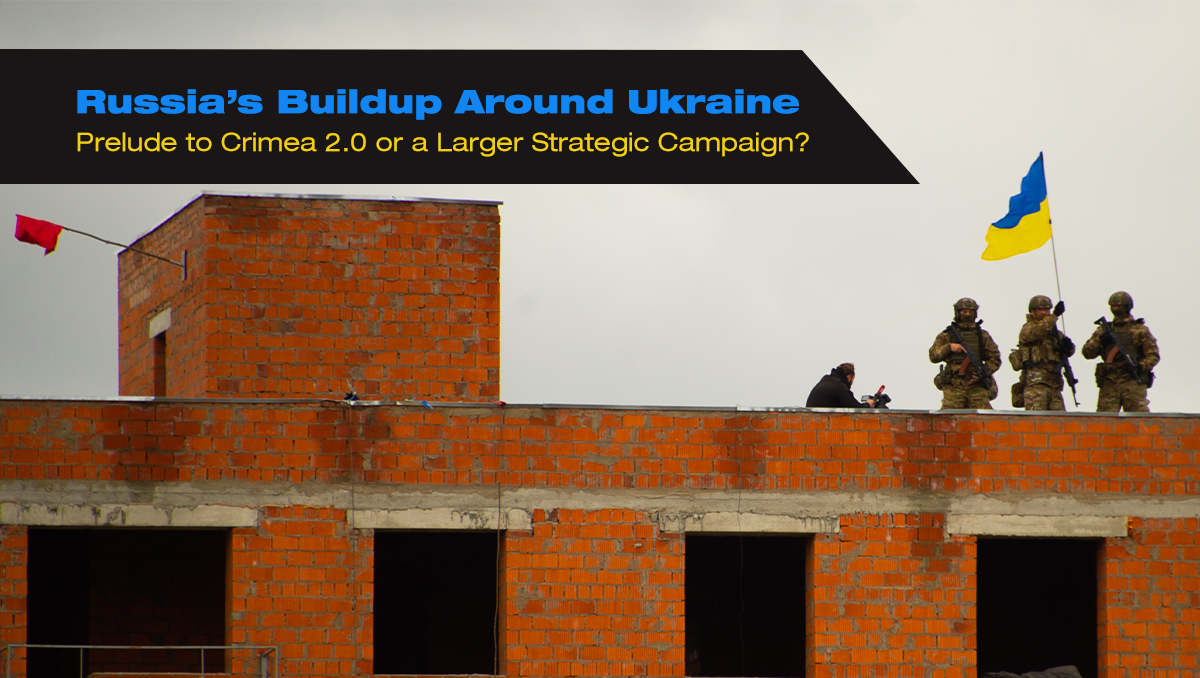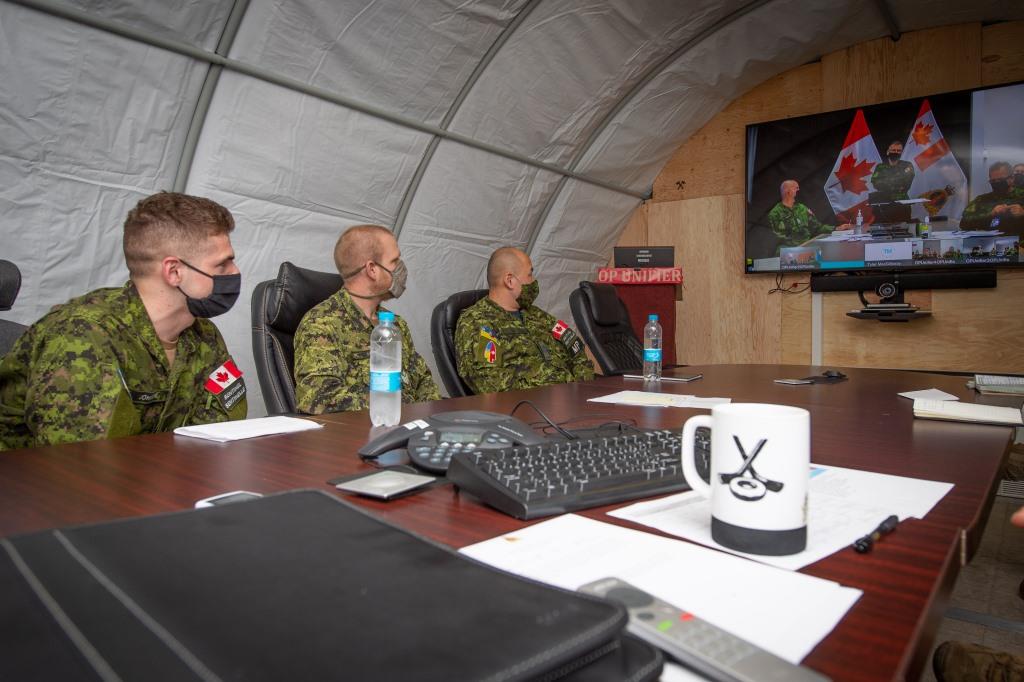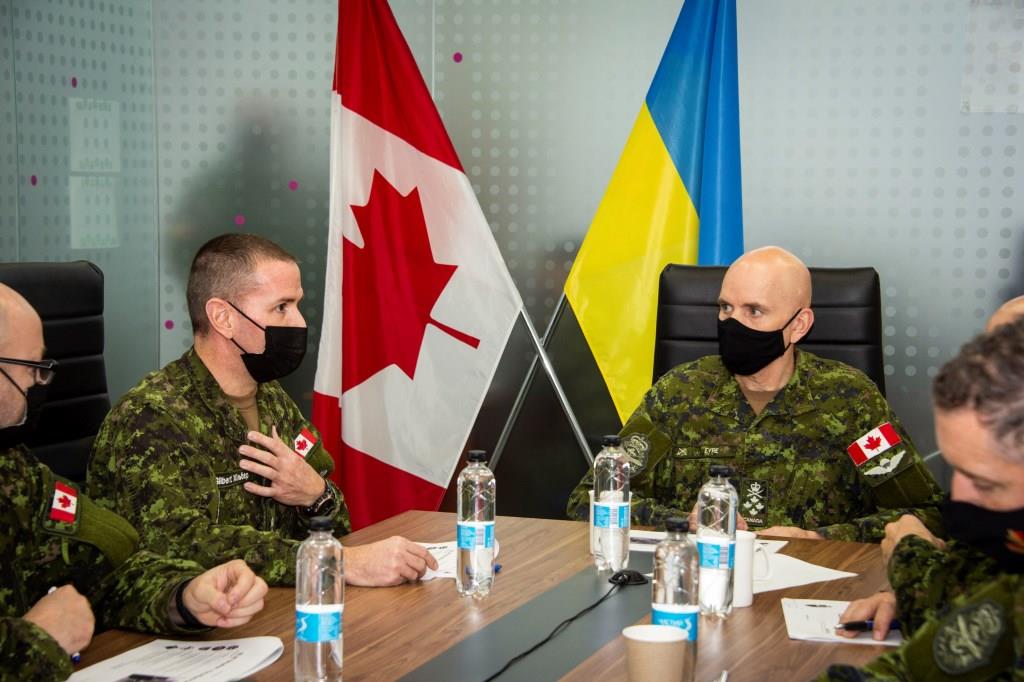RUSSIA'S BUILDUP AROUND UKRAINE
BY RICHARD NGHIEM
Russia’s Buildup Around Ukraine
Prelude to Crimea 2.0 or a Larger Strategic Campaign?
 After five years of frozen conflict and relative peace in Eastern Ukraine, military tensions between Moscow and Kyiv have escalated once again. As part of a ‘high readiness training exercise’, President Putin has recently amassed thousands of tanks, ballistic missiles, and more than 175,000 troops to the north, south, and east of the Donbass region of Ukraine, which has been controlled by pro-Russian separatists since 2014. These significant deployments do not even take into account Russia’s naval buildup in the Sea of Azoz and the tens of thousands of additional troops stationed in Crimea. What is truly more alarming, though, is that most of the divisions, positioned along the border with Ukraine, are Russia’s most elite military formations. For example, among these deployed units is the vaunted 1st Guards Tank Army, a formidable armoured fighting force, consisting of the highly decorated 2nd Motor Rifle and 4th Tank guards divisions. Additional crack, top-of-the-line forces are also still flowing into the region by rail from southern and western Russia. These events have consequently led many US and NATO defence officials to believe that a second invasion of Ukraine may be imminent.
After five years of frozen conflict and relative peace in Eastern Ukraine, military tensions between Moscow and Kyiv have escalated once again. As part of a ‘high readiness training exercise’, President Putin has recently amassed thousands of tanks, ballistic missiles, and more than 175,000 troops to the north, south, and east of the Donbass region of Ukraine, which has been controlled by pro-Russian separatists since 2014. These significant deployments do not even take into account Russia’s naval buildup in the Sea of Azoz and the tens of thousands of additional troops stationed in Crimea. What is truly more alarming, though, is that most of the divisions, positioned along the border with Ukraine, are Russia’s most elite military formations. For example, among these deployed units is the vaunted 1st Guards Tank Army, a formidable armoured fighting force, consisting of the highly decorated 2nd Motor Rifle and 4th Tank guards divisions. Additional crack, top-of-the-line forces are also still flowing into the region by rail from southern and western Russia. These events have consequently led many US and NATO defence officials to believe that a second invasion of Ukraine may be imminent.
However, not all security analysts are convinced as some have dismissed this buildup as just another sabre-rattling exercise and regular show of force by the Kremlin, while others believe that the purpose of this massing of troops is to signal to the West that Ukrainian membership in NATO would cross a ‘redline’ for Moscow. While these assessments may have some merit, President Putin’s recent actions clearly convey that this mobilization is no ‘training exercise’. His decision to consolidate most of Russia’s best divisions, from Moscow all the way to Siberia, in one region near Ukraine is extraordinarily aggressive and leaves Russia’s border defences in many regions incredibly thin. Such a gamble and bold move is not made lightly; it is only made in times of war or in preparation for war, which in this case, is a second incursion into Ukraine.
To support this assertion, significant American satellite imagery and surveillance has determined that currently deployed Russian units can quickly and easily disperse from their staging areas and conduct sustained military operations against Ukraine for weeks, with the equipment and supplies already available to them in theatre. One must also take into account the buildup of Russian forces specifically around Pogonovo and its more strategic northern location relative to Ukraine. By having a significant amount of troops positioned there, President Putin could order a much larger military campaign against Ukraine all along its border, not just from the south. This makes sense from a military operational point of view as this staging area is 250 km northeast of the Kyiv-controlled territory in Luhansk region, but over 400 km from the separatist-controlled Lugansk People’s Republic in Ukraine, thereby increasing Moscow’s attack options. Some defence analysts have also suggested that this massive military buildup is possibly being used as a diversion to enable the covert movement of Spetsnaz forces, “little green men”, weapons, and supplies into separatist-controlled Donbas as part of a more aggressive, expansive, but deniable escalation against the West by Moscow. Both of these possibilities pose an extremely concerning threat to NATO, especially in light of the Kremlin’s recent harder stance on Ukraine. President Putin has not only attacked Kyiv’s Western ties and aspirations for NATO membership, but also openly questioned its sovereignty. As a result, this, as stated before, has led many analysts and advisors to believe that this buildup is a prelude to another Crimea 2.0.
STRATEGICALLY WELL-PLACED KALININGRAD
Or is it a prelude to something much greater? While all eyes have been on Russia’s massive military buildup on the border of Ukraine, Moscow has also quietly made numerous bold, aggressive moves in the Baltic region, especially in Kaliningrad and Belarus. With regards to the former, a small exclave on the Baltic coast bordering Lithuania to the north and east, Poland to the south, and Belarus to the east, Kaliningrad is in a very dangerous, strategically well-placed position right in the heart of mainland Europe. President Putin is fully aware of this and has transformed it into a massive long-range ballistic missile garrison. In recent years and months, Russia has deployed several more advanced Iskander missile units to the stronghold and expanded all Iskander brigades in the enclave from 12 to 16 launchers each. This will allow for more than 32 hypersonic missiles to be fired in one salvo at strategic NATO military installations or capital cities throughout all of mainland Europe as these weapons have an impressive range greater than 500 km. To demonstrate this, Kaliningrad’s 152nd Guard Missile Brigade – taking into account its reloads – can unleash two volleys of 24 highly precise hypersonic missiles that can hit and destroy targets within six meters, more than 310 miles away. This puts major capital cities such as such as Berlin, Tallinn, and Warsaw at constant significant risk.
Besides its long-range ground based hypersonic and ballistic missiles, this stronghold also fields some impressive offensive naval, air, and electronic warfare forces and capabilities. For example, it is home to five Karakurt and Buyan-M corvettes, each armed with eight newly acquired Kalibr cruise missiles, capable of hitting strategic land targets 1,500 miles deep inside the European continent. It also possesses an amphibious assault capability in the form of the elite 336th Alexander Nevskii Naval Infantry Brigade, composed of two amphibious APC mechanized battalions, one airborne assault battalion, and several armoured artillery units. Supporting this naval infantry unit are also four Ropucha-class landing ships, a dozen smaller landing craft, and a Spetznaz special forces unit. With regards to offensive air power, it has Su-24M supersonic bombers and newly deployed Su-30 multi-role fighters, both of which can carry out offensive maritime and air-to-air missions. Finally, in the electronic warfare domain, it houses naval electronic warfare and intelligence units which can intercept signals traffic throughout the Baltic region and carry out signal jamming missions, even against GPS satellites, more than three thousand miles away, with their new powerful Murmansk-BN jamming systems. Overall, these weapon systems make Kaliningrad a powerful, threatening, forward positioned garrison right in NATO’s backyard.
Therefore, to safeguard this strategic, vital arsenal from NATO attacks and ensure that it will always be a major player or threat in a future potential conflict, President Putin has significantly stepped up the enclave’s defences in all domains. For example, the 44th Air Defence Division, already composed of eight formidable battalions of S-300 and S-400 surface-to-air missile batteries, and shorter range Pantsir systems, has been recently augmented with dozens of additional S-400 and new ‘stealth killer’ S-500 systems. These new batteries, with the ability to launch SAMs at aerial targets over 250-300 miles away, can defend against any incoming NATO fighter aircraft or missiles over all of Poland, Lithuania, and Belarus. This is also not just theoretical, based on merely missile range data, as it is enabled by newly deployed and powerful 29B6 Konteyner over-the-horizon radar systems to detect targets at those long distances. While officially unverified, according to the Russian Defence Ministry, this new radar system can track aerial activity as far away as the UK and the Mediterranean. Taken all together, with all of these advanced assets, Kaliningrad is not only a ballistic and hypersonic missile enclave, but also one of the most heavily defended outposts in the world with an extremely dense and extensive air defence network.
RUSSIA & BELARUS
Ukraine and Kaliningrad are not the only areas that Russia has focussed its attention on. Russia has also been very active militarily in Belarus, which is located right next to Kaliningrad. From carrying out massive joint Russian-Belarusian Zapad-2021 military exercises in September to supplying the Belarusian government with $1 billion worth of arms for building military infrastructure and permanently basing its Su-30 fighter jets at Baranovichi air base in western Belarus, Russia is, without question, accelerating that country’s military’s incorporation into its own. Furthermore, a joint military training centre has also been erected in the western Belarusian city of Hrodna, near the border with Poland and Lithuania. This has already caused both of these NATO countries to be on edge and to put their military forces on high alert.
In other words, the West cannot just focus on a potential Russian attack on Ukraine as Moscow is also currently making a move in Belarus and strengthening its missile arsenal in Kaliningrad. Instead, it must be aware of and recognize the larger strategic picture of Russia’s ‘pincer’ advance on central Europe both from the north (Belarus and Kaliningrad) and the south (Ukraine). Russia’s military activity in the Baltic region is just as alarming as its actions around Ukraine. With its enormous buildup of long-range ballistic missiles, nuclear weapons, fighter aircraft and S-400s in Kaliningrad right in the heart of Europe, Moscow’s ability to threaten almost every major European capital has grown tremendously. In addition, Russia’s increased military presence in both Belarus and Kaliningrad poses an imminent and significant threat to the Suwałki gap, a key land bridge connecting Baltic States with Poland and their other NATO allies. With increased troop concentrations positioned on both flanks of this small but strategic sliver of flat land just inside Poland, Moscow is in a dangerously stronger position to isolate and cut off the Baltic states from the rest of mainland Europe and re-incorporate them into Russia’s sphere of influence. This is what President Putin has wanted to do for decades as he views this region as historically and culturally, an inherent part of Russia. He also sees its people as ethnic Russians.
While some defence analysts may reject this theory of a two pronged ‘pincer’ military advance on central Europe and NATO and view Russia’s buildup around Ukraine as mere posturing, these assessments must at least be taken into consideration. Furthermore, whatever Russia’s true strategic intentions may be on the continent, the West can not just continue to pursue diplomacy, public rhetoric, and economic sanctions to curb Moscow’s actions and hope for the best as these measures obviously have had no deterrent effect on President Putin’s aggressive decision making. This is clearly demonstrated by the dire situation in Ukraine right now with Russia’s continued covert military operations inside its borders, logistical support for loyal separatist fighters to undermine the government in Kyiv, and ongoing military buildup.
CAF & NATO
As a result, the time has come for NATO to take point and respond to Moscow with a massive show of force of its own, not just in Ukraine, but also in the Baltic states, as only from a position of strength, can the West negotiate with President Putin. However, right now, the alliance, without significant assistance from the Pacific-focused United States, is woefully unprepared for such a task. Unfortunately, this is especially true with regards to Canada’s Armed Forces (CAF).
To remedy this, the Canadian federal government must first and foremost fully acknowledge the resurgence of Russia as a great power, something it has not seemingly grasped or taken seriously based on its actions. It also needs to understand the entire strategic picture of Europe, not just Ukraine, despite it being unquestionably the number one hotspot in the region. As explained previously, Russia is not just building up around Ukraine, but also in Kaliningrad and Belarus to the north. These two latter military deployments pose just as grave a threat to the Baltic states of Estonia, Latvia, and Lithuania as Russia’s presence in southeast Europe presents to Ukraine. Not to mention, the Baltic states are actually part of NATO while Ukraine is not. Consequently, besides its CAF battlegroup already in Latvia, Ottawa should also deploy a new contingent of troops to Lithuania and significantly expand the scale and scope of the CAF’s Operation UNIFIER in Ukraine.
With regards to the latter, while its roughly 200 forward deployed soldiers have done a magnificent job in training more than 12,500 members of Ukraine’s military since 2015, the CAF must now shift its role in the country to one of deterrence and direct defence against Russian aggression. However, to do this with any credibility, it must boost its presence in the region considerably, modernize its equipment, and demonstrate that it can operate and thrive within a highly contested, heavily defended A2/AD zone, similar to China’s in the West Pacific. This is crucial as Russia’s area denial zones on the border of Ukraine, around Crimea and Kaliningrad, and across the entire Black Sea, while different in focus, are equally formidable. They are enforced by hundreds of anti-ship ballistic missile batteries, dozens of fast attack missile patrol boats and frigates, and Kalibr missile armed SSNs. These defences are further augmented by Russia’s extensive cyberattack, electronic warfare, and signal jamming capabilities. Lastly, but most importantly, Moscow’s A2/ AD zones arguably boast the most dense and sophisticated integrated air defence systems in the world, with top-of-the-line S-400 and S-500 SAM batteries, and incredibly long-range radars.
As a result, faced with these intimidating area denial apparatuses across the continent, Canada’s military has been viewed by many defence experts as inconsequential in any future potential armed conflict in Europe. While this is unquestionably true as of today, the CAF, if modernized and restructured properly, can become relevant again and play an important role in deterring any further Russian aggression.
Stay tuned to CDR for the second installment of this article, where we examine what actions Canada and the CAF need to take in order to deter further Russian aggression.
Article Submission by Richard Nghiem


